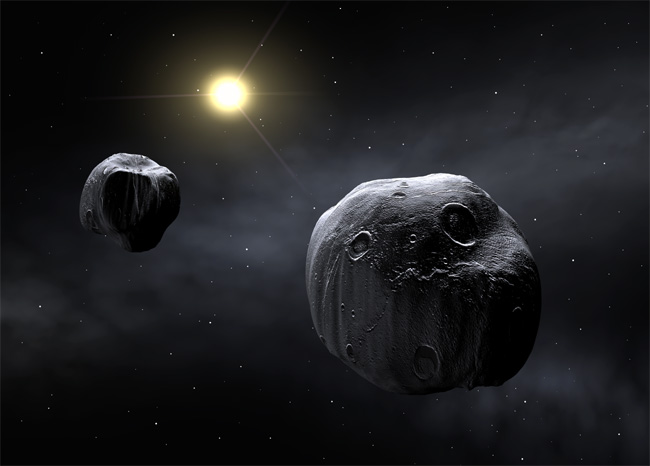Amateur and Professional Astronomers Cooperate to Map Dancing Asteroid

The motions of an asteroid with two whirling parts are now better known, thanks to a rare collaboration between professional and amateur astronomers.
Called 90 Antiope, the asteroid consists of two egg-shaped rubble piles locked in orbit, like two twirling dancers facing one another with linked arms. Antiope is thought to be the remnants of a larger asteroid, dubbed Themis, which astronomers think was destroyed by an impact with another asteroid some 2.5 million years ago.
The finding is detailed in the April 2007 issue of the scientific journal Icarus.
Using the 10-meter Keck II telescope in Hawaii, astronomers discovered in 2000 that Antiope, once thought to be a typical asteroid floating between the orbits of Mars and Jupiter, actually consists of two gravitationally linked space rocks.
Subsequent observations by Keck II and the Very Large Telescope in Chile determined the orbits of Antiope's two parts, each of which were found to be about 53 miles (86 km) in diameter and separated by about 106 miles (171 km).
But uncertainties remained, and in 2005 the team invited observers around the world to turn their telescopes on the asteroid pair when they were predicted to undergo a mutual eclipse and occultation. In an eclipse, one member of the duo casts a shadow over the other; in an occultation, one passes in front of the other, completely blocking its light.
The open invitation paid off, and over a period of six months, professional and amateur astronomers teamed up and observed numerous eclipses and occultations by Antiope.
Breaking space news, the latest updates on rocket launches, skywatching events and more!
Some of the amateur astronomers seemed absolutely tickled to share the spotlight with professionals. "What is really a thrill is to have my little 7-inch telescope with an 8-meter telescope on the same paper. It is unbelievable," said Peter Dunckel, 75. Dunckel observed Antiope from the backyard of his vacation home in Grass Valley, California, for 35 hours over a period of six weeks.
The combined observations allowed scientists to refine their estimates of Antiope's motions and confirmed the ellipsoid shape of each of the asteroid's parts. They also found that the asteroid is made largely of rubble and is about 30 percent empty space.
"Amateurs can be used for professional studies, compensating for the small size of their telescopes by the large number of observations and the frequency of observations they can do," said study team member Franck Marchis, an astronomer at the University of California, Berkeley.
- Top 10 Strangest Things in Space
- Dancing Asteroid Mapped in Motion
- Cosmic Paparazzi: Asteroids Caught With Mates -- asteroid pairs and moons
Ker Than is a science writer and children's book author who joined Space.com as a Staff Writer from 2005 to 2007. Ker covered astronomy and human spaceflight while at Space.com, including space shuttle launches, and has authored three science books for kids about earthquakes, stars and black holes. Ker's work has also appeared in National Geographic, Nature News, New Scientist and Sky & Telescope, among others. He earned a bachelor's degree in biology from UC Irvine and a master's degree in science journalism from New York University. Ker is currently the Director of Science Communications at Stanford University.
